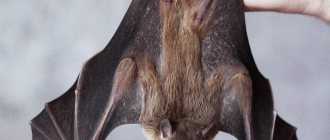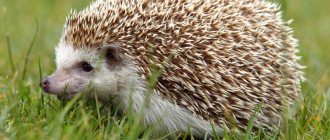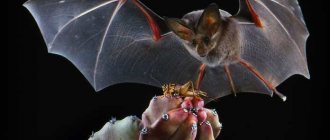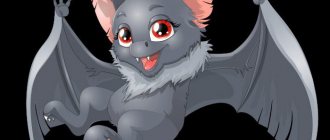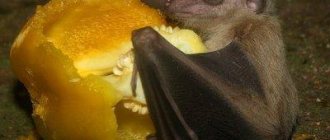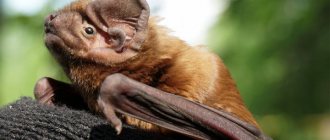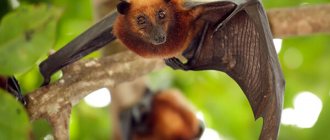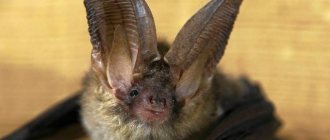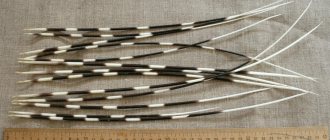- How do bats navigate in the dark?
Contrary to their name, their bat namesakes are not even related to ordinary mice. While ordinary mice belong to the order of rodents, bat mice are representatives of the order Chiroptera, which has little overlap with rodents. But where did the name "bat" come from? The fact is that bats were so named due to their small size and squeak, very similar to the squeak of mouse rodents.
Description, structure, characteristics
The order Chiroptera, to which bats actually belong, is especially notable for the fact that they are, in fact, the only mammals capable of flight. Now, it’s true that the order of chiropterans includes not only flying mice, but also other no less flying brethren: flying dogs, flying
foxes, as well as fruit bats, which differ from their counterparts - ordinary bats, both in their habits and in their body structure.
As we already mentioned, bats are small in size. The weight of the smallest representative of this species, the pig-nosed bat, does not exceed 2 grams, and the body length reaches a maximum of 3.3 cm. In fact, this is one of the smallest representatives of the animal kingdom.
The largest representative of the bat family, the giant false vampire, has a mass of 150-200 g and a wingspan of up to 75 cm.
Different species of bats have different skull structures, the number of teeth also varies and largely depends on the diet of a particular species. For example, the tailless long-tongued leaf-nosed insect, which feeds on nectar, has an elongated facial part. Nature wisely made it so that he had somewhere to accommodate his long tongue, which in turn is necessary for getting food.
But predator bats that feed on insects already have a so-called heterodont dental system, which includes incisors, canines and molars. Small bats, which eat even smaller insects, have up to 38 small teeth, while large vampire bats have only up to 20. The fact is that vampires do not need many teeth, since they do not chew their food. But they have sharp fangs that make a bleeding wound on the body of the victim.
Traditionally, bats, almost all species, have large ears, which are responsible, among other things, for their amazing echolocation abilities.
The forelimbs of bats were transformed into wings over a long period of time.
evolution. The elongated fingers began to serve as the frame of the wing. But the first finger with the claw remains free. With its help, bats can even eat and perform various other actions, although in some of them, such as smoky bats, it is not functional.
The speed of a bat depends on the shape and structure of its wing. They, in turn, can be very long, or vice versa with a slight extension. Wings with a lower aspect ratio do not allow them to develop high speed, but they can be easily maneuvered, which is very useful for bats living in the forest, which often have to fly among the treetops. In general, the flight speed of a bat ranges from 11 to 54 km per hour. But the Brazilian folded lip, from the genus of bulldog bats, is the absolute record holder for flight speed - it is capable of reaching speeds of up to 160 km per hour!
The hind limbs of bats have a characteristic difference - they are turned to the sides with the knee joints back. With the help of well-developed hind legs, bats hang upside down, and in this seemingly (to us) uncomfortable position they sleep.
Bats, like any decent mammals, have a tail, which also varies in length depending on the species. They also have bodies (and sometimes limbs) covered with fur. The coat can be smooth, shaggy, short or thick, again depending on the species. The color also varies, usually whitish and yellowish shades predominate.
A Honduran white bat with a very unusual coloring - white fur contrasts with yellow ears and nose.
However, there are also representatives of bats with a body completely without hair - these are two naked-skinned bats from Southeast Asia.
The vision of bats leaves much to be desired; the eyes are poorly developed. In addition, they do not distinguish colors at all. But poor eyesight is more than compensated by excellent hearing, which, in fact, is the main sense organ in these animals. For example, some of the bats can detect the rustling of insects swarming in the grass.
Their charm is also well developed. For example, females of the Brazilian folded lip are able to find their cubs by smell. Some bats sense their prey by smell, as well as by hearing, and can also distinguish between “their” and “foreign” bats.
Yellow-winged False Vampire / Lavia frons
This cute little animal is the only representative of the Lavia genus, and it lives in Central Africa.
With a body size of only 60-80 mm, the wingspan is 35 cm. They settle in dense forests near water bodies and spend the night on tree branches.
This species forms monogamous families and occupies a certain territory, which is protected by the male. The distance between the resting places of individual couples does not exceed 20 m.
13
Orientation in the dark
It's simple, bats “see with their ears.” After all, they have such an amazing property as echolocation. How does it work? And so, animals emit ultrasonic waves, which are reflected from objects and return back through an echo. Incoming return signals are carefully recorded by bats, thanks to this they are perfectly oriented in space and even hunt. Moreover, through reflected sound waves they can not only see their potential prey, but even determine its speed and size.
To emit ultrasonic signals, nature has equipped bats with a specially designed mouth and nose. First, the sound originates in the throat, then is produced by the mouth and goes to the nose, radiating through the nostrils. The nostrils themselves have various bizarre projections that serve to shape and focus sound.
People can only hear how bats squeak, because the ultrasonic waves emitted by them are not perceived by the human ear. Interesting fact: earlier, when humanity did not know about the existence of ultrasound, the amazing orientation of bats in pitch darkness was explained by the presence of extrasensory abilities.
Pet house
Despite its small size, a bat at home needs a very spacious enclosure where the pet will be able to fly. It is necessary to equip the house with branches and shelters so that the animal has the opportunity to hide during the daytime rest.
The vital functions of bats directly depend on the ambient temperature, so the room where the pet lives should be approximately 30 degrees, which is quite high for a comfortable stay for a person.
A bird cage is not always suitable for keeping bats, since the distance between the twigs is sufficient so that one fine night you can find that the animal is flying above your heads and happily feasting on insects.
Habitats
They live practically all over the world, of course, with the exception of the cold Arctic regions. But most of them live in the tropics and subtropics.
Bats are nocturnal or crepuscular. During the day, they usually hide in various shelters, both underground and above ground. They especially love caves, quarries, mines, and can hide in tree hollows or under branches. Some bats even take shelter under bird nests during the day.
Bats, as a rule, live in small colonies - up to several dozen individuals. But there are colonies of bats that are much more populous; the colony of Brazilian folded lips is considered a record, boasting the presence of 20 million individuals. On the other hand, there are bats that prefer to lead a solitary lifestyle.
California Leafnose / Macrotus californicus
As the name implies, this representative of a large order of leaf-nosed insects lives in the southwestern United States and Mexico.
Adults do not grow more than 6 cm, and weigh from 15 to 20 grams. But the wingspan is quite impressive, reaching 30 cm. They love dry, warm deserts, in which they masterfully hunt insects.
For hibernation, they choose abandoned mines or residential buildings, but most of all they settle in large colonies in caves.
2
Why do bats sleep upside down?
The seemingly strange habit of bats sleeping upside down, hanging on their hind legs, also has very practical reasons. The fact is that this position allows them to instantly take flight. To do this, you just need to unclench your paws. Thus, less energy is wasted and time is saved, which can be very important in case of danger. The hind legs of bats are designed in such a way that hanging on them does not require the expenditure of muscle energy.
Nutrition
Most bats feed on insects, but there are also absolute vegetarians among them, preferring pollen and plant nectar, as well as various fruits. There are also omnivorous bats that love both plant foods and small insects, and some large species even hunt fish and small birds. Bats are excellent hunters, largely due to their wonderful echolocation property, which we described above. Vampire bats stand apart in terms of nutrition, feeding exclusively on the blood of wild and domestic animals (however, they can also feast on human blood), hence the name.
Insectivores
Mice that eat insects don't eat everything.
Each animal has its own taste preferences. Some people love bugs and midges, some love butterflies and moths, while others enjoy eating small spiders or enjoying wood larvae.
Mice can hunt such small prey either in groups or individually.
Mice only catch insects in the air. Thanks to ultrasound, they calculate the location of the insect and capture it.
Some species prefer to immediately swallow the prey in the air, others grab it with their wings, as if it were a net or blades.
Others use their tail membrane. They form a net and catch the insect with it.
But there are very few such bats. Usually hunting and eating occur at the same time, but sometimes mice throw a “dinner party” for a family or even a colony.
Types, photos and names
Here is a description of the most interesting bats in our opinion.
White leaf-nosed bat
It is especially interesting for its appearance, yellow ears and nose against a background of white fur. It also differs from other bats in the absence of a tail. The white leaf-nosed plant is very small in size, its body length does not exceed 4.7 cm, and its weight is 7 grams. Leaf-noses live in South and Central America, preferring moist forests as a home. They are herbivores and feed exclusively on fruits. They live in small colonies of up to ten individuals.
Giant noctule
The giant noctule is the largest bat found in Europe. The body length of the noctule reaches 10 cm, and the weight is 76 grams. Has brown fur. The noctule usually lives in forests, inhabiting tree hollows. You can also find it on the territory of our Ukraine. Feeds on large insects, beetles,
butterflies. Also listed in the Red Book.
Hog-nosed bat
It is notable for the fact that it is the smallest representative of the bat family. Its length is only 2.9-3.3 cm, and everything is no more than 2 grams. However, it has quite large ears. The nose is very similar to the snout of a pig, hence the name of this species. The pig-nosed bat's color is often gray or dark brown. They live in Southeast Asia, especially many of them live in Thailand and its neighboring countries. An interesting feature in the behavior of pig-nosed mice is their collective hunting. They hunt in groups of up to five individuals at night. Due to their small numbers, pig-nosed bats are currently listed in the Red Book.
Two-color cauldron
This species got its name due to the color of its fur, which has two colors - its back is red or dark brown, and its belly is white or gray. The two-colored kazan lives across a wide range: from England and France to the Pacific Ocean. These bats are found not only in natural conditions, but also in human cities; they can easily live in the attics and eaves of houses. Night for them is the time to hunt for various small animals - flies,
mosquitoes, moths Also endangered.
Water bat
She is also Daubanton's bat, named after the French naturalist Louis Jean Marie Daubanton. It is small in size, its length is no more than 5.5 cm, and its weight is up to 15 grams. The fur color is usually dark or brown. The habitat is the same as that of the kazhan, almost throughout the entire territory of Eurasia. The life of the water bat is closely connected with bodies of water (hence the first name), it is near them that they like to hunt, especially mosquitoes, which are also found in abundance near ponds and lakes.
Brown long-eared bat
The Ushan is so named due to its amazing, by no means small, ears. The long-eared bat also lives in Eurasia, but is also found in North Africa. They like to live in mountain caves, where they lead a sedentary lifestyle.
Dwarf bat
He is also the small-headed bat - the smallest representative of bats in Europe, his body length is no more than 45 mm, and his weight is up to 6 grams. His body really is very similar to that of an ordinary mouse, only with wings. This species also loves to settle in places close to humans.
Great horseshoe bat
This species is mountainous, as it loves to settle in mountain caves, canyons, and crevices. It lives over a wide geographical range - Eurasia and North Africa, wherever there is mountainous terrain you can find a large horseshoe bat. They hunt moths and beetles.
Common vampire
It is thanks to this species that bats, which are generally very useful in the ecosystem (at least by killing mosquitoes), have their bad reputation. But an ordinary vampire, in fact, like the famous Count Dracula, feeds on blood, including possibly human blood. But as a rule, various domestic animals become their victims and food supply:
cows, horses, pigs. Vampires, as expected, go about their dark business at night, when their victims are in deep sleep. They sit on them unnoticed, biting through the skin of the victim, from which they then drink blood. However, a vampire’s bite is invisible and painless due to the special secret that they possess. But this is where the danger lies, since the victim may die from blood loss. A vampire bite can also transmit the rabies or plague virus. Fortunately, vampire bats live only in the subtropics of Central and South America; in our latitudes, bats are absolutely harmless.
Lesser pipistrelle / Pipistrellus pygmaeus
In a large genus of pipistrelle bats, this is its smallest representative, not growing more than 45 mm. But its wings are from 18 to 21 cm.
Widely distributed throughout Europe, and settles near rivers and small streams. This is due to the fact that its diet is dominated by aquatic midges and land insects.
Buildings and, less often, tree hollows are chosen as resting places. They fly out to hunt at dusk, and spend time in shelters during the day.
9
Enemies in nature
Bats also have their own enemies, who in turn can hunt them. Usually these are birds of prey: peregrine falcons, hobby birds,
hawks, and also owls. A snake, marten and weasel will not mind grabbing a bat.
But the main enemy of bats (as well as many other animals) is, of course, humans. The use of chemicals in crop production has significantly reduced the number of bats; many of the species are already listed in the Red Book, as they are on the verge of extinction.
Red Hairtail / Lasiurus borealis
These amazing creatures live in North America, and by eating large quantities of insects, they help farmers preserve their crops.
This species is easily identified by the characteristic red color of its fur. They grow small and, like everyone else, are nocturnal. They spend daytime in dark secluded corners, hiding in caves or abandoned buildings.
Interestingly, females can give birth to twins and even quadruplets - double pairs of twins. In the first period, the female carries the cubs on her body, thereby giving them her warmth for life and development.
7
Benefit
But the benefits of bats are much greater:
White-bellied Arrowhead / Otonycteris hemprichii
A small mammal from the order Chiroptera was named after a German zoologist, and therefore in some reference books you can find the name Hemprich's arrow-eared bird.
The range of this wonderful creature is limited to Egypt and the Arabian Peninsula; it can also be found in the desert regions of Morocco. Their belly is light, but their back is covered with dark brown or sand-colored fur.
It lives in rock crevices, as well as in residential buildings, and is active at night, hunting insects.
10
How to get rid of bats
But still, if bats have settled near the house, for example, under the roof, despite all their benefits, they can be annoying, especially because of their squeaking. To get rid of bats under your roof, cottage or attic, you need to follow these instructions:
- First you will need to find a place where bats rest during the day. Then, after waiting for them to fly away for the night hunt, simply cover this place with a crowbar or something else.
- You can try to smoke them out.
- You can spray their habitats with special sprays whose odors will repel mice.
Where do they spend the winter?
In the winter months, when there is a complete lack of food supply, some bats migrate south, and the majority fall into a state of suspended animation (evening bats, bats, bats, bats).
During hibernation, the bat's body temperature drops to 1-3 degrees, and the heartbeat and breathing slow down significantly.
Before wintering, mice accumulate fat, which accumulates in the upper back. They look for shelter in caves, tree hollows, and under the roofs of houses. The time at which bats hibernate depends on the region and climate conditions. The duration of hibernation ranges from 3 to 8 months.
Interesting Facts
- Bats always fly to the left side of cover.
- Substances contained in the saliva of vampires are now used as medicines to prevent the formation of blood clots.
- If in our culture bats are associated with vampires and other evil spirits, then in Chinese culture they are, on the contrary, symbols of harmony and happiness.
- The bat is very voracious, so in an hour it can eat up to 100 mosquitoes, in human terms, this is about the same as eating a hundred pizzas in an hour.
Malayan short-nosed fruit bat / Cynopterus brachyotis
The short-nosed fruit bat lives in southern and southeastern Asia and feeds on mangoes, although it can also eat other tropical fruits.
For the flora of this region of the planet, it plays an important role in plant pollination, since the mouse’s diet includes nectar and pollen. They weigh only 21-32 grams, and their life expectancy is 20-30 years.
At birth, the baby of this unique fruit bat can fit on the tip of a human finger.
14
Video
And finally, an interesting video about bats.
Author: Pavel Chaika, editor-in-chief of Poznavaika magazine
When writing the article, I tried to make it as interesting, useful and high-quality as possible. I would be grateful for any feedback and constructive criticism in the form of comments on the article. You can also write your wish/question/suggestion to my email [email protected] or Facebook, with respect, the author.
Author page
